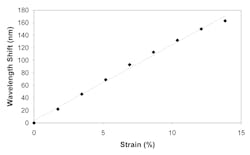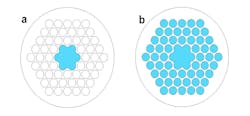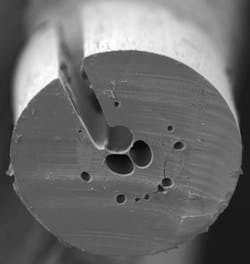MARYANNE LARGE
Unlike conventional optical fibers, which use two different transparent materials to guide the light, microstructured fibers use a pattern of tiny holes that run the full length of the fiber. They were first invented in the UK in 1996 and have since become one of the hottest areas of optics because, by varying the pattern of these holes, it is possible to get some unique and important optical effects such as single-mode guidance without a cut-off wavelength, the ability to tailor the dispersion and polarization properties, and, most impressively, the ability to use new guidance mechanisms (photonic bandgap and inhibited coupling) to guide light in low-refractive-index materials such as air or water.
All this initial work, however, was done on glass fibers. Researchers at the University of Sydney realized that making these types of structures in polymer had some real advantages. It is possible, for example, to combine the unique properties of microstructured fibers with the vast range of polymer processing techniques. It is also possible to sidestep some of the problems with conventional polymer fibers—for example, by allowing a large variety of fiber structures (such as single-mode, graded-index, and multicore) to be made using a single fabrication technique. Such an approach can lend itself to economical mass manufacturing, while retaining optical properties that are hard to obtain in conventional polymer optical fibers (POFs).
Wide variety of applications
Some of the most important advantages of conventional POF-based systems are their ruggedness, ease of handling, and cost. They allow for a variety of sensing applications such as the sensing of strain, deformation, and distance. With the application of microstructured POFs, however, the spectrum of sensor applications becomes even broader.
Perhaps the most significant advantage of microstructured polymer optical fibers (mPOFs) from a sensing perspective is that, for the first time, they make single-mode sensing fibers that operate in the visible range easy to fabricate (see Fig. 1). Single-mode POFs are typically difficult to make because the polymer's low processing temperatures mean that diffusion can destroy the fiber's index profile. Conventional single-mode polymer fibers have been made before, but they typically have extremely high loss. With the microstructured approach, single-mode polymer optical fibers can be readily made—an extremely significant development for sensing, as most of the usual interrogation methods require single-mode fibers. Such interrogation methods include the use of gratings (Bragg and long-period) and interferometric techniques.
One area in which this technology is likely to prove extremely interesting is strain sensing. The use of polymer brings particular advantages to strain sensors, allowing much larger strains to be measured. By way of comparison, the Young's modulus (a measure of stiffness) of silica is 72 GPa, compared to 3.2 GPa for the polymer poly(methyl methacrylate)—an improvement of more than an order of magnitude. Polymer fibers can also be stretched far more (30% to 40%) than glass fibers without breaking (see Fig. 2).These characteristics mean there is a range of applications that are simply impossible with glass fibers and can now be addressed using polymer fibers. Such fibers can be used to measure very large strains, and they can measure strain in materials that have low values of the Young's modulus without the need to artificially reinforce the materials. Because of these advantages, mPOF-based sensors are being investigated by groups in Germany, the U.S., Australia, and the UK for applications as diverse as breathing sensors (for patients in MRI machines), earthquake monitoring, measuring strain in composite materials, and in fragile artworks.
Fluid sensing
The fact that mPOFs have holes in the cladding region, and can even have a hollow or microstructured core, also opens up significant new opportunities for fluid sensing. Fluid sensing in conventional optical fibers is difficult because of the low refractive indices of fluids, which means guidance by total internal reflection (TIR) is impractical.
Microstructured optical fibers offer two elegant solutions to this problem, both of which have been experimentally demonstrated (see Fig. 3). A fiber with a selectively filled core can be used in conjunction with a high air fraction in the cladding region, or a fully filled bandgap can be used. In both cases, the microstructure confines both the light and the fluid and allows almost a complete overlap of the optical field with the fluid—a dramatic improvement over evanescent-field sensors that are the conventional fiber alternative. Another approach uses a microstructured core, though such an approach relies on the evanescent field being maximized and produces a mode profile that makes efficient launching challenging.The University of Sydney group has begun exploring biosensing applications, using hollow-core fibers for measuring optical activity in small volumes of chiral liquids. Chirality (the property of a structure that has a nonidentical mirror image) is a critical issue in pharmacology because, for most drugs, only one chiral form is biologically active.
The group has also used hollow-core fibers as a platform for surface-enhanced Raman spectroscopy (SERS). As its name suggests, SERS is based on the Raman effect—an information-rich spectroscopy that can "fingerprint" even very similar compounds. While Raman is a very weak effect, in SERS there is a potentially huge enhancement in intensity that occurs at a metal interface. The difficulty in implementing SERS as a clinical diagnostic is that the size of the signal depends very strongly on the shape and features of the metal interface. While not all the problems have been solved, using a metal colloid in a hollow-core fiber shows promising results in making SERS a more quantitative technique.
Another advantage of mPOFs for biosensing is their high surface-area/volume ratio. A group working at the Technical University of Denmark (Copenhagen, Denmark) has demonstrated the selective detection of antibodies immobilized on the surface of mPOFs. The attachment of the antibodies to the polymer is a relatively easy step—far less complicated than it would be in glass.
Side-hole mPOF
Aqueous sensing for medical or environmental applications makes this area a very active one, with continuous online monitoring being one of the targets. The development of a "side-hole" fiber is significant in this regard, because it simplifies the filling of the fiber, and separates it from the coupling of light in and out of the ends (see Fig. 4).While the side-hole fiber allows the rapid ingress of fluids close to the sensing region, it also allows efficient surface treatment on the core. Most surface treatments on interior surfaces of the holes in microstructured fibers have required the fluids to pass through the full length of the fiber. This approach is problematic for some applications, both because it intrinsically treats a very long section of the fiber and because it does not allow the full range of processing techniques to be applied. In particular, surface-plasmon resonance (SPR) requires the application of a very high-quality metal layer. Using the side-hole approach, we can apply this layer externally using sputtering, which is known to produce high-quality films. This method was recently used to produce the first experimental demonstration of an SPR sensor in an mPOF. Particularly exciting is that, because polymers are mechanically flexible and don't produce harmful shards, they could be used for in vivo sensing.
The use of mPOF has unique advantages for sensing. Like other polymer fibers, they are robust, biocompatible, and have excellent mechanical properties. Now, mPOF adds the advantages of microstructured fibers: They can be made single-mode in the visible, allowing the use of fiber gratings and interferometry; they can be filled with fluids and still guide light; and the surface of their holes can be treated to interact with biomolecules or coated in metals for plasmonic effects. They are, in reality, a new and exciting platform for compact ultrasensitive sensors.
Maryanne Large is a research fellow in the optics group at the Institute of Photonics and Optical Science, University of Sydney, Sydney, NSW 2006, Australia; e-mail: [email protected].



